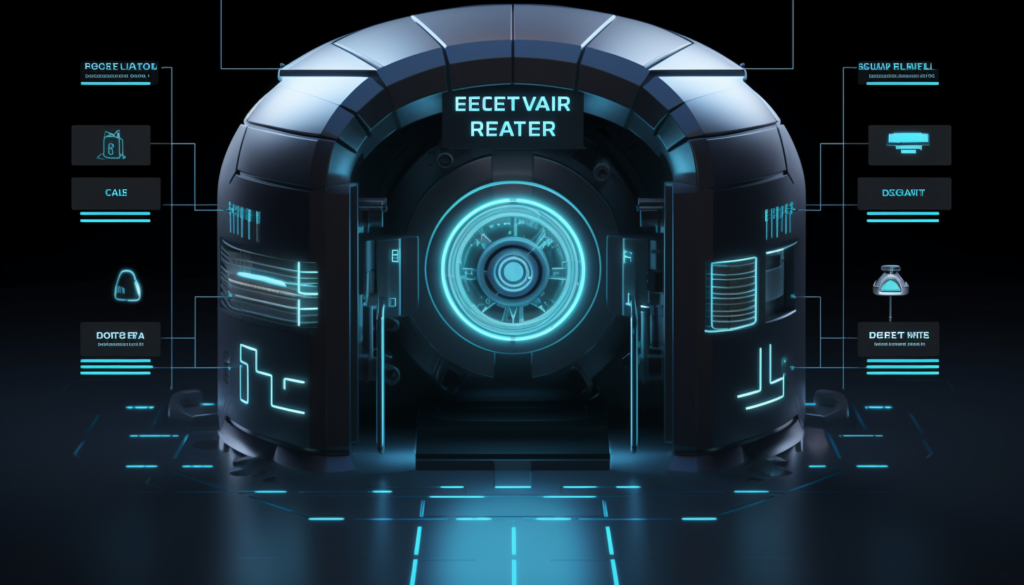WHAT IS ZERO TRUST SECURITY MODEL? UNPACKING THE BUZZWORD CHANGING CYBERSECURITY

If you’re puzzled by the endless jargon and complex language that often surrounds the topic of cybersecurity, you’re not alone.
But don’t worry, we’re here to break it down for you, starting with one of the most important concepts shaping the future of digital security: Zero Trust.
Think about your home—you wouldn’t just leave your front door wide open, right? And even if someone has a key, you’d still want to know who’s coming and going.
Zero Trust works on a similar principle but for your digital space. Instead of assuming everything inside your network is safe, Zero Trust takes a ‘trust nothing, verify everything’ approach.
In traditional security models, once you’re inside the network, you generally have access to everything.
That’s like letting someone into your house and then giving them free rein to open any drawer or door. Zero Trust changes all that.
Even if a user or system is inside the network, it must continually prove it’s supposed to be there—kind of like having a security guard inside your house, asking for ID every time someone wants to enter a room.
What is Zero Trust Security Model?
Zero Trust is not just a catchphrase, but a revolutionary approach to cybersecurity. It is based on the principle that organizations should not automatically trust anyone or anything, both inside and outside their network perimeter.
Instead, every user, device, and application must be verified and authorized before accessing any resources.
The concept of Zero Trust can be summarized in three key principles:
1. Least Privilege: Users and devices are granted the minimum level of access required to perform their tasks. This reduces the risk of unauthorized access and limits the potential damage in case of a breach.
2. Micro-Segmentation: The network is divided into smaller segments, or micro-perimeters, with strict access controls. This prevents lateral movement within the network and contains any potential threats.
3. Continuous Authentication: Rather than relying solely on static credentials like usernames and passwords, Zero Trust employs continuous authentication methods such as multi-factor authentication (MFA) and behavioral analytics.
4. This ensures that only authorized users can access resources, even if their credentials have been compromised.
Zero Trust security measures provides a proactive approach to cybersecurity, reducing the risk of data breaches, insider threats, and lateral movement by attackers.
It challenges the traditional notion of trust and emphasizes the importance of verifying every user, device, and application. By adopting this approach, organizations can better protect their sensitive data and stay one step ahead of cyber threats.

Core Principles of the Zero Trust Model
Zero Trust is a security concept that challenges the traditional approach of assuming trust within a network.
It operates on the principle that organizations should not automatically trust any user or device, whether inside or outside their network perimeter.
Instead, access to resources and sensitive data should be granted on a need-to-know basis, with continuous verification and authentication.
The core principles of Zero Trust can be summarized as follows:
1. Identity Verification: Every user, device, or application attempting to access resources must be verified and authenticated before being granted access. This involves multi-factor authentication, strong passwords, and other identity verification methods.
2. Least Privilege: Users are only given the minimum level of access necessary to perform their tasks. This reduces the risk of unauthorized access or privilege escalation.
3. Micro-segmentation: Networks are divided into smaller segments, with strict controls and policies in place for each segment. This limits lateral movement within the network and contains potential threats.
4. Continuous Monitoring: Continuous monitoring and analysis of user behavior, network traffic, and system logs are essential to detect anomalies and potential security breaches in real-time.
5. Encryption: Data should be encrypted both in transit and at rest to protect it from unauthorized access or interception.
6. Access Control: Access controls should be implemented at every level, including network, application, and data layers. This ensures that only authorized users can access specific resources.

Benefits of Zero Trust
Zero Trust is a security model that is gaining popularity in the digital world. It operates under the principle of “never trust, always verify.”
In this approach, every user and device, whether inside or outside the network perimeter, is treated as potentially untrusted.
This ensures that security measures are in place at every level, providing numerous benefits for organizations.
One of the key advantages of implementing a Zero Trust Security model is enhanced security.
By assuming that every user and device is potentially untrusted, organizations can implement strict access controls and authentication measures.
This significantly reduces the risk of unauthorized access and potential data breaches.
Another benefit is improved visibility and control. With Zero Trust, organizations have a clear understanding of who is accessing their systems and what actions they are performing.
This level of visibility allows for better monitoring and detection of any suspicious activities or anomalies.
Zero Trust also promotes flexibility and scalability. Traditional security models often rely on perimeter defenses, which can be limiting in today’s dynamic business environment.
With Zero Trust, organizations can adapt to changing needs and easily scale their security measures as their business grows.
Additionally, Zero Trust can help organizations meet compliance requirements.
By implementing strict access controls and authentication measures, organizations can ensure that sensitive data is protected in accordance with industry regulations.
Steps to Implement Zero Trust Architecture
Implementing a Zero Trust Architecture may sound daunting, but it doesn’t have to be.
Here are some key steps to get started:
1. Identify and classify your assets: Start by understanding what assets you need to protect and categorize them based on their sensitivity.
2. Implement strong authentication: Require multi-factor authentication for all users and devices to ensure only authorized individuals can access resources.
3. Segment your network: Divide your network into smaller segments or micro-perimeters to limit lateral movement in case of a breach.
4. Monitor and analyze: Implement continuous monitoring and analysis of network traffic to detect any anomalies or suspicious activities.
5. Encrypt data: Protect sensitive data by encrypting it both at rest and in transit.
6. Regularly update and patch: Keep all software and firmware up to date with the latest security patches to prevent vulnerabilities.

Zero Trust Technologies and Tools
Implementing Zero Trust requires a combination of technologies and tools that work together to create a secure environment. Here are some recommended ones:
1. Identity and Access Management (IAM) systems: IAM systems play a crucial role in Zero Trust by ensuring that only authorized individuals have access to sensitive data and resources.
These systems authenticate users, enforce access policies, and provide centralized control over user access.
2. Multi-Factor Authentication (MFA): MFA adds an extra layer of security by requiring users to provide multiple forms of identification, such as a password, fingerprint, or facial recognition.
This helps prevent unauthorized access even if a password is compromised.
3. Network Segmentation: Network segmentation divides a network into smaller, isolated segments, making it harder for attackers to move laterally within the network.
By implementing strict access controls between segments, organizations can limit the potential damage caused by a breach.
4. Endpoint Security: Endpoint security solutions protect individual devices, such as laptops and smartphones, from malware and other threats.
These solutions often include features like antivirus software, firewalls, and encryption to ensure the security of endpoints.
5. Security Information and Event Management (SIEM) systems: SIEM systems collect and analyze security event data from various sources to detect and respond to potential threats.
They provide real-time monitoring, threat intelligence, and incident response capabilities.
Zero Trust vs Traditional Security Models
Zero Trust is a revolutionary approach to cybersecurity that challenges the traditional notion of trust within a network.
In the past, organizations relied on perimeter-based security models, where they would establish a secure boundary around their network and trust that everything inside that boundary was safe.
However, with the increasing sophistication of cyber threats, this model has proven to be ineffective.
The concept of Zero Trust is simple yet powerful: trust no one and verify everything. It operates on the principle that no user or device should be automatically trusted, regardless of their location or network connection.
Instead, every access request is thoroughly authenticated and authorized before granting access to any resource.
One of the key differences between Zero Trust and traditional security models is the shift from a network-centric approach to an identity-centric approach.
In traditional models, once a user gains access to the network, they are often granted broad privileges and can freely move within the network.
This creates a significant security risk as an attacker who gains access to one part of the network can easily move laterally and access sensitive data.
In contrast, Zero Trust focuses on granular access controls based on user identity, device health, and other contextual factors.
Each access request is evaluated in real-time, and only the minimum necessary privileges are granted. This significantly reduces the attack surface and limits the potential damage an attacker can cause.
Another important aspect of Zero Trust is continuous monitoring and adaptive security. Unlike traditional models where security measures are static and often outdated,
Zero Trust continuously assesses the trustworthiness of users, devices, and applications throughout their entire lifecycle.
This allows for immediate detection and response to any suspicious activity or policy violations.

Challenges and Considerations in adopting Zero Trust
Zero Trust is a security concept that is gaining popularity in the digital world.
It is a framework that assumes that no user, device, or network should be trusted by default, regardless of their location or credentials.
Instead, it requires continuous verification and authentication for every access request.
While Zero Trust offers numerous benefits, there are also challenges and important considerations to keep in mind when implementing it.
Complexity:
Implementing Zero Trust can be complex, especially for organizations with legacy systems and traditional network architectures.
It requires a shift from perimeter-based security to a more granular approach, which may involve restructuring networks and implementing new technologies. This can be time-consuming and resource-intensive.
User Experience:
Zero Trust can potentially impact user experience, as it introduces additional layers of authentication and verification. Organizations need to strike a balance between security and usability to ensure that employees and customers can access resources efficiently without compromising security.
Integration:
Integrating Zero Trust into existing security infrastructure can be challenging. It requires coordination between different departments and stakeholders, including IT, security, and compliance teams. Compatibility issues may arise when integrating new technologies with legacy systems.
Training and Education:
Implementing Zero Trust requires educating employees about the new security measures and best practices. Training programs should be implemented to ensure that employees understand the importance of Zero Trust and how it affects their daily work routines.

Successful Zero Trust Use Cases Implementations
Several organizations have embraced the Zero Trust model and achieved remarkable success in enhancing their cybersecurity posture. Let’s explore some real-world examples:
1. Google: As one of the world’s leading technology companies, Google implemented Zero Trust Security to protect its vast network and sensitive data.
By adopting a holistic approach that includes strong authentication, strict access controls, and continuous monitoring, Google has significantly reduced the risk of unauthorized access and data breaches.
2. Dropbox: The popular cloud storage provider recognized the need for a more robust security framework and implemented Zero Trust principles.
By implementing multi-factor authentication, granular access controls, and encryption at rest and in transit, Dropbox has enhanced the security of its users’ data, ensuring confidentiality and integrity.
3. Cisco: As a global leader in networking and cybersecurity solutions, Cisco understands the importance of staying ahead of evolving threats.
By implementing Zero Trust Security across its network infrastructure, Cisco has strengthened its defenses against internal and external threats, ensuring that only authorized users and devices can access critical resources.
These case studies demonstrate the effectiveness of Zero Trust Security in protecting organizations from cyber threats.
By adopting this approach, businesses can mitigate the risk of data breaches, unauthorized access, and other security incidents, ultimately safeguarding their reputation and customer trust.
Final Thoughts – What is Zero Trust Solution
Zero Trust is a revolutionary approach to cybersecurity that challenges the traditional perimeter-based security model.
By assuming that no user or device can be trusted, Zero Trust focuses on verifying and validating every access request, regardless of whether it originates from inside or outside the network.
This approach provides enhanced security and mitigates the risk of data breaches and unauthorized access.
Key takeaways from this article include:
1. Zero Trust is a security framework that requires continuous verification and validation of every access request.
2. It assumes that no user or device can be trusted, regardless of their location or network.
3. Zero Trust focuses on granular access controls, multi-factor authentication, and continuous monitoring to enhance security.
4. Implementing Zero Trust requires a shift in mindset and a comprehensive evaluation of existing security practices.
5. The future of Zero Trust is promising, as organizations increasingly recognize the need for stronger cybersecurity measures.
FAQ (Frequently Asked Questions)
Q: Is Zero Trust suitable for all types of organizations?
A: Yes, Zero Trust can be implemented by organizations of all sizes and industries. It provides a proactive approach to cybersecurity that can benefit any organization concerned about data protection.
Q: Does implementing Zero Trust require significant investment?
A: While implementing Zero Trust may require some initial investment, the long-term benefits outweigh the costs. It is a proactive approach that can save organizations from potential data breaches and financial losses.
Q: Can Zero Trust completely eliminate the risk of cyberattacks?
A: While Zero Trust significantly reduces the risk of cyberattacks, it cannot guarantee complete elimination. However, by implementing strong security measures and continuously monitoring access requests, organizations can greatly enhance their cybersecurity posture.
Q: How can an organization start implementing Zero Trust?
A: Implementing Zero Trust requires a comprehensive evaluation of existing security practices, identifying vulnerabilities, and gradually transitioning to a Zero Trust architecture. It is recommended to seek guidance from cybersecurity professionals to ensure a smooth implementation process.

